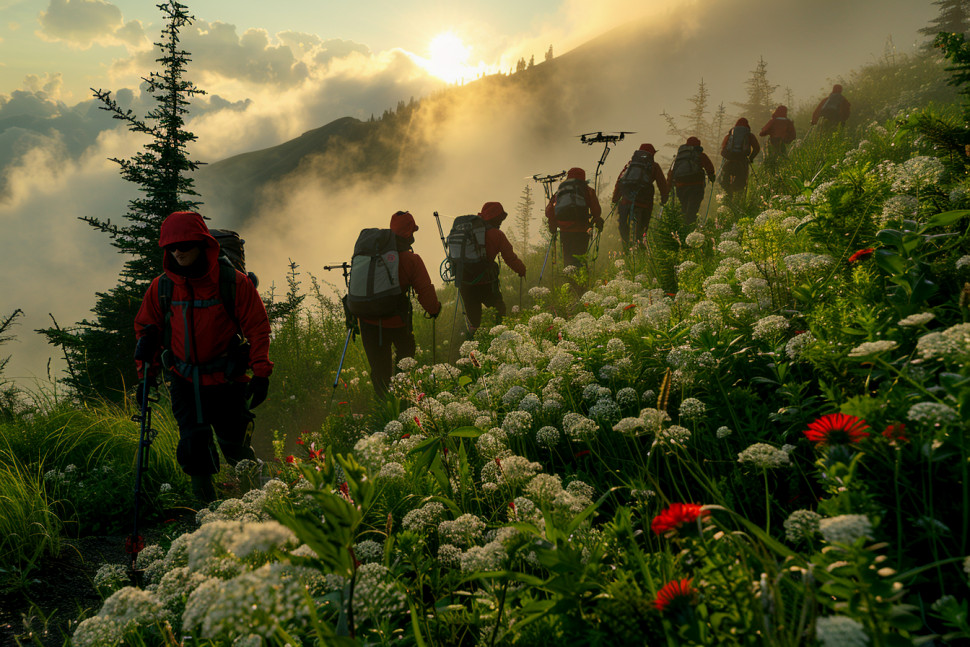Emergency Response Protocols in the Wilderness: Ensuring Safety in Remote Campsites

Key Takeaways
- Develop an emergency response plan before your trip that covers communication, evacuation, first aid, and survival
- Always let someone know your detailed trip plans and expected return time
- Carry multiple emergency communication devices like a satellite messenger, PLB, and whistle
- Pack a well-stocked first aid kit and know how to use it to stabilize injuries or illnesses
- Be prepared to initiate a search and rescue operation if someone in your group goes missing
- Have a plan for emergency survival shelters, fire-starting, signaling, and water purification
- Practice your emergency protocols through drills and scenarios before heading into the wilderness
Why Emergency Preparedness Matters in Remote Campsites
Picture this nightmare scenario - you're camping deep in the backcountry, miles from the nearest road or cell phone tower. Suddenly, your friend slips on a wet log and fractures their leg. Would you know what to do? How would you call for help or safely evacuate your injured friend?
Emergencies can strike anytime, anywhere - but they're especially dangerous in remote wilderness settings. When you're far from definitive medical care, a serious injury or illness can quickly turn life-threatening if you're not prepared to handle it.
That's why having solid emergency response protocols is absolutely essential before heading into the backcountry. You need to have a plan for how to deal with worst-case scenarios, because your life or the life of a friend could depend on it. Proper preparation and practicing your emergency skills can make all the difference.

Developing Your Wilderness Emergency Response Plan
Benjamin Franklin once said "If you fail to plan, you are planning to fail." This definitely applies to backcountry emergency preparedness. Having a written emergency response plan is crucial for any wilderness trip. Your plan should cover:
- Communication methods and devices for calling for help
- Evacuation procedures for getting an injured person to definitive care
- First aid protocols for stabilizing and treating common injuries/illnesses
- Survival priorities if your group becomes stranded (shelter, water, food, warmth)
- Delegation of roles and responsibilities among group members
- Key emergency contact info and nearest hospital/ranger station
Make sure everyone in your group is familiar with the plan and their role in an emergency situation. Review and practice your protocols together before your trip. Consider running through some potential scenarios. The more you prepare and drill, the more it will be second nature if a real crisis occurs.
Always Leave a Detailed Trip Plan With Emergency Contacts
One of the most important parts of your emergency plan happens before you even set foot on the trail. You should ALWAYS leave a detailed trip plan with a reliable friend or family member back home. This plan should include:
- Your exact route, campsites, and planned return time/date
- Vehicle information (make, model, color, license plate) at the trailhead
- Names and emergency contact info for everyone in your group
- Local emergency resources (nearest ranger station, hospital, etc)
Instruct your contact to notify authorities if you are overdue by a certain amount of time. This could be the difference between a minor inconvenience and a major search and rescue operation. It gives rescuers a starting point of where to look if your group doesn't return as planned. Don't forget to let your contact know when you've returned safely so they don't unnecessarily initiate a search!

Carry Multiple Backcountry Emergency Communication Devices
When calling 911 isn't an option, you need to get creative with emergency communication methods in the wilderness. Don't rely on just one device - bring multiple options in case one fails. Here are some essentials to pack:
- Satellite messenger device (SPOT, InReach, etc) for sending SOS messages via satellite
- Personal Locator Beacon (PLB) for one-way distress signaling
- Satellite phone for two-way voice communication (more expensive)
- Whistle for audible close-range distress signaling
- Signal mirror, flares, smoke signals, or high-visibility markers for visual signaling
Know how to use each device and keep them easily accessible. Consider delegating a communications leader in your group who is in charge of all the devices. Do a function check on all electronics before your trip. Pack extra batteries and keep devices in waterproof cases.
Stock a Robust First Aid Kit (And Know How to Use It)
When you can't call 911, you are the first responder. Your group needs to be self-sufficient in providing emergency medical care in the field. That starts with a well-stocked first aid kit that goes beyond just Band-Aids and Neosporin. Some wilderness first aid essentials include:
- Tourniquet and hemostatic gauze for severe bleeding control
- SAM splint and elastic bandages for fracture/sprain stabilization
- Trauma shears, tweezers, irrigation syringe, medical gloves
- Oral rehydration salts and anti-diarrheal for dehydration/GI issues
- Epinephrine auto-injector for anaphylaxis from severe allergic reactions
- Prescription medications taken by anyone in the group (labeled in original bottles)
Just as important as having the right supplies is knowing how to use them. Take a wilderness first aid class as a group to learn how to assess and treat common injuries and illnesses. Make sure your first aid kit is well-organized and everyone knows where to find things. Check expiration dates and restock before each trip.

Be Prepared to Initiate a Search and Rescue Operation
If someone in your camping group goes missing, you may need to initiate your own search and rescue effort while waiting for professional help to arrive. Time is of the essence, so it's important to have a plan and act quickly. Here are the key steps:
-
Gather information. When and where was the person last seen? What were they wearing/carrying? Are there any clues to their intended route or destination?
-
Organize a hasty search. Send small teams of 2-3 to quickly check high-probability areas like trails, water sources, or known hazards. Blow whistles and call the person's name. Look for signs like footprints, gear, or evidence of a fall.
-
Establish a perimeter. Post lookouts at key terrain features like river crossings or trail junctions to contain the search area. Searchers should have a way to communicate with each other and the command post.
-
Expand the search. If the hasty search is unsuccessful, switch to a grid search pattern to systematically cover the entire area. Mark searched segments on a map to avoid duplication of effort.
-
Document and preserve clues. If you find footprints, take a photo next to a reference object for scale. Secure any located belongings for scent dogs. Record GPS coordinates of any clues.
Remember, your first priority is the safety of the remaining group. Never put additional people at risk in the search effort. Know when to back off and wait for professional help. Searching is a skill that requires training - consider taking a class or volunteering with your local SAR team for practice.
Have a Survival Plan If You Become Stranded
Even the best-laid plans can go awry. If an emergency strands your group in the wilderness, you need to be prepared to survive until help arrives. Remember the survival rule of 3s - you can survive 3 hours without shelter, 3 days without water, and 3 weeks without food. Prioritize accordingly:
-
Shelter: Be prepared for unexpected nights out. Carry emergency bivvies, lightweight tarps, or the materials to build a natural shelter. Insulate from the ground.
-
Fire: Fire provides warmth, light, a signal, and a morale boost. Always carry 3 ways to make fire, like matches, a lighter, and a ferrocerium rod. Know how to build a fire in all conditions.
-
Water: Carry a water filter or chemical treatment tablets. Know how to locate water sources and collect water in the wild.
-
Food: It's a lower priority, but pack extra rations in case you're out longer than planned. Focus on calorie-dense, non-perishable foods.
-
Signaling: A whistle, signal mirror, and bright markers like surveyor's tape can help rescuers locate you. Make yourself big and visible from the air.

Practice Your Emergency Skills Before You Need Them
The key to a successful wilderness emergency response is practice. You don't want to be figuring things out for the first time in the middle of a crisis. Schedule regular practice sessions with your camping group to drill your emergency protocols. Some skills to work on:
- Setting up emergency shelters and building fires in bad weather
- Splinting fractures and controlling bleeding with your first aid gear
- Calling for help on your satellite communication devices
- Navigating with map and compass to find your way to safety
- Signaling for rescue with whistles, mirrors, and ground-to-air signals
The more you practice, the more muscle memory and confidence you will build. Debrief after each drill to discuss what went well and what needs improvement. Update your written emergency plan as needed based on your practice sessions.
Wildlife Encounter Preparedness: Essential Safety Tips for Campers
Campers should prioritize wildlife encounter preparedness by familiarizing themselves with essential safety tips. Understanding how to safely store food and dispose of waste can help prevent attracting unwanted animal visitors. Keeping a safe distance and avoiding direct contact with wildlife is crucial for both camper and animal well-being. Additionally, campers should research the specific wildlife in the area they plan to visit to better prepare for potential encounters. By following these safety measures, campers can enjoy a safer and more harmonious experience in nature.
Camping safety tips for beginners
For beginners, it is crucial to choose a well-lit and easily accessible campsite. Ensure to pack essential items such as a first aid kit, flashlight, and extra food and water. Familiarize yourself with local wildlife and follow wildlife safety precautions. Always inform someone of your camping plans and expected return time. Lastly, secure your campsite by properly storing food and disposing of waste to deter wildlife.
Conclusion
Wilderness camping is an incredible way to connect with nature, but it comes with inherent risks. A medical emergency or a lost group member can quickly turn a dream trip into a nightmare if you're not prepared. Having solid emergency response protocols is essential for the safety of your group in remote campsites.
Remember, you are your own first responder in the backcountry. Take the time to develop a thorough emergency plan that covers communication, evacuation, first aid, and survival. Practice your skills regularly through drills and scenarios. And always leave a detailed trip plan with emergency contacts before heading into the wilderness.
With proper planning and preparation, you can have peace of mind to relax and enjoy the majesty of the great outdoors. Stay safe out there!
